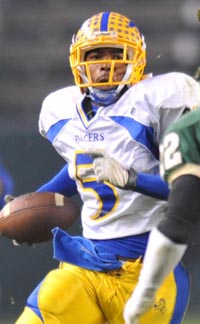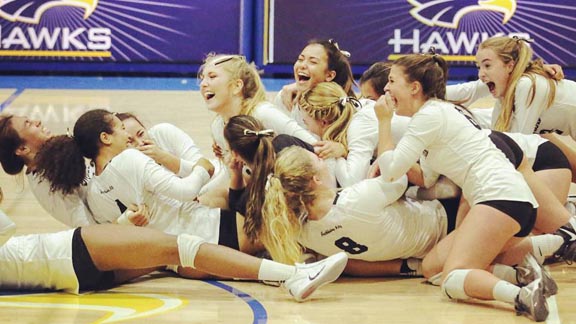
Li’Angelo Ball (left) grabs rebound for Chino Hills during 2016 CIF Open Division boys final. At right, K.C. Waters (44) of Bishop O’Dowd tries to slow down Windward’s Macchiati Smith during first-ever CIF Open Division girls final in 2013. Photos: Willie Eashman.
It began with a famous (or infamous depending on point of view) football vote in 2008, but the CIF Open Division format has evolved over the years to the current inclination for there to be more byes for both the Southern California and Northern California regional playoffs. We’ll wait until Sunday to see how that plays out for this season in boys and girls basketball. This column includes comments from CIF executive director Ron Nocetti.
We hope to enjoy this free feature on CalHiSports.com. If you are not a Gold Club member and want to see all of our all-state teams this season (boys & girls) plus final state rankings and more, please sign up today. You can now join for one-month rate of just $3.99. For subscription info, CLICK HERE.
In the world of high school sports in California, it can often be all about the bylaws.
If it’s written into them, there isn’t anything anyone can do to go around them. The bylaws have to be changed.
At the California Interscholastic Federation level, the evolution of the Open Division bracket at the top of various sports — including boys and girls basketball — has been greatly impacted by those bylaws.

When the Open Division concept first popped up, for the 2008 football season and championed by former CIF Sac-Joaquin Section commissioner Pete Saco, many CIF sections at the time still conducted their own playoffs according to school enrollments and school enrollment also was still used as a factor for the CIF bowl games. That’s why in the first CIF state bowl games in 2006 the No. 1 ranked team in the state overall, Oaks Christian of Westlake Village, participated in the Division III state final and not Division I. CIF Southern Section Pac-5 Division champion Servite of Anaheim also was in D2 in 2009.
That first CIF Open Division football choice remains controversial to this day. The CIF section commissioners voting at the time selected Grant of Sacramento from the north to play Long Beach Poly from the south, but easily could have gone with longtime powerhouse De La Salle of Concord from the north or Corona Centennial from the south.
Since then in football, the CIF Open Division choice almost has become a foregone conclusion from the beginning of the season with De La Salle in the north vs. the winner of the CIFSS D1 title (either St. John Bosco or Mater Dei) for the south. That’s more due to the addition of competitive equity based playoff divisions in the CIFSS than anything at the CIF level, but looking back at the first CIF Open Division vote also shows that the one factor that has never changed in later Open Division selections is that no matter the sport, no matter the region (north or south), every season plays out differently. In some years, the favorites separate themselves at the section level, but in others upsets complicate the picture.
Basketball added its open divisions for the 2012-13 season with Mater Dei (with four-time state champ Stanley Johnson) topping Archbishop Mitty of San Jose (led by two-time robbed NBA slam dunk champ Aaron Gordon) for the first boys state title while Bishop O’Dowd of Oakland defeated Windward of Los Angeles for the girls.

Sacramento Grant’s Darvin McCauley had a huge game when Pacers beat Long Beach Poly in 2008 in the first CIF Open Division state final in football. Photo: Scott Kurtz.
Girls volleyball went to an Open Division four years ago with Archbishop Mitty generating history in that sport as well since it won the first two CIF Open Division titles in 2016 and 2017.
“We certainly could add more Open Divisions,” said first-year CIF executive director Ron Nocetti during an interview earlier this week. “As more sports get along with some history that now have just regional playoffs, yes we could add them (as part of state championships). There has been a lot of discussion about it for soccer and water polo.”
The goal of having Open Divisions at the top of state championship playoffs is to ensure that the best of the best teams are playing each other regardless of school enrollment or section playoff division. It’s a system that other than that first year in football has indeed decided final No. 1 overall state rankings.
Nocetti recalled that having to have eight-team brackets in Open Divisions (according to the bylaws) was why some of the most dominating teams from boys and girls hoops in subsequent Open Division state brackets — like the Chino Hills boys in 2016 or the Archbishop Mitty of San Jose girls in 2018 — were not able to have first-round byes. Sure, it was a joke that Chino Hills that year had to play an Immanuel of Reedley team that should have been in a lower division, but the spot had to be filled and the bylaws at the time (which also limited how many CIFSS teams could be taken) didn’t give the CIF much wiggle room.
Byes in the Open Divisions for basketball actually have been around since the first tournament in 2013, however. It’s just that those first ones — for the SoCal girls in 2013 and both the NorCal and SoCal boys in 2014 — were because the CIF couldn’t uplift enough teams into the Open Division. At the time, there also were bylaws that spelled out a series of criteria that teams had to meet in order to be selected for the Open Division.
Since the bylaws surrounding criteria were eliminated a few years ago, byes at first were not awarded. The only reason there was one two years ago for NorCal girls basketball is that one of the qualifying teams, Carondelet of Concord, took itself out of the playoffs due to several players being caught drinking alcohol.
Even last season, the CIF didn’t have any byes in the Open Division for Southern California in either boys or girls hoops, but did have one in the north for boys and two in the north for girls.

Archbishop Mitty players celebrate after winning 2018 CIF Open Division state title in volleyball. That was only the second Open Division state playoff in that sport. Photo: @mittyvolleyball/Twitter.com.
Using historical results, the difference in byes should be more in favor for the north than the south. The south has superior depth of outstanding, state-ranked teams. With the south already having an advantage, the theory goes, why put even more of the north’s top teams in the Open Division since it will weaken the north’s depth in Division I and continuing downward into other divisions.
This last girls volleyball season showed that when the entirety of a season’s results is considered, the CIF will have no problem using multiple byes for an Open Division. Those results, including the CIF Southern Section’s top division, created an obvious separation after the CIFSS D1 playoffs for three teams — Mater Dei, Redondo Union (Redondo Beach) and Marymount (Los Angeles) — plus the top two in the CIF San Diego Section Open Division — Torrey Pines and Cathedral Catholic. Did the CIF force any other teams up into its Open Division? Not at all. The SoCal regional had first-round byes for Torrey Pines (the eventual champion), Redondo and Mater Dei with only one first-round match, which was Cathedral Catholic vs. Marymount.
“The key is looking for clear separation,” Nocetti said when asked if the CIF is indeed now showing more of a trend toward more and not less first-round Open Division byes. “We don’t want to re-play what just happened in the Southern Section. We don’t want to repeat it.”
Which brings us to the current basketball season in which Open Division regional brackets will be determined and released this Sunday. There actually hasn’t been much separation created in the CIFSS Open Division for both boys and girls.
The best guess heading into the CIFSS finals this weekend — Mater Dei vs. Sierra Canyon for boys plus Mater Dei vs. Windward for girls — is that the CIF may have to take as many as six teams from the CIFSS Open Division both boys and girls (with only two teams from each bracket going to D1) into its SoCal Open brackets. Those six, and even a few of the others, have simply been beating each other most of the season. And other than the La Jolla Country Day girls and perhaps Fairfax of Los Angeles boys, there also aren’t any other teams from outside of the CIFSS that have the quality wins and strength of schedule frankly to be considered at the same level.
Nocetti admitted that the Open Division works best when there are highly ranked teams in San Diego or the L.A. City Section that can legitimately be paired up with the CIFSS teams.
“I’d never use the word ‘rooting’ for one team over another, but it’s always better when it’s like that,” Nocetti said. “We want it to be as true of a regional championship as possible.”
Is the Open Division here to stay? Since competitive equity seeding and the like are an off-shoot of it and is continuing to expand in various sections around the state, that’s a big YES. It has been slow to expand to other states, but Arizona added it for the 2019 football season and in its first-ever Open Division final it was a matchup of two national top 25 ranked teams that previously would have played in separate divisions.
“Many state associations reach out to us about it,” Nocetti said. “Similar to us, there’s just a lot of growing pains. The interest may be there, but you also have to sell it to your schools.”
Mark Tennis is the co-founder and publisher of CalHiSports.com. He can be reached at markjtennis@gmail.com. Don’t forget to follow Mark on the Cal-Hi Sports Twitter handle: @CalHiSports




